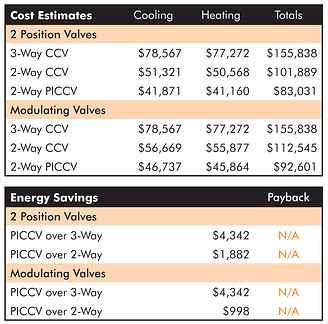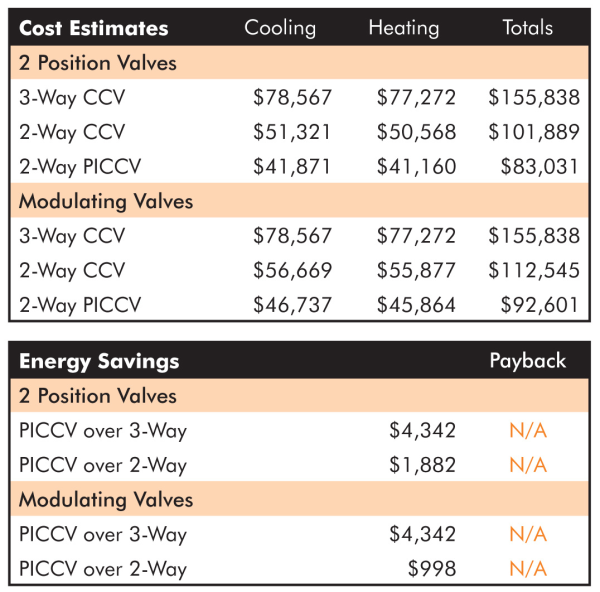Straight Answers About Pressure Independent Technology
Confused about conflicting information regarding the effectiveness of Pressure Independent (PI) Technology!?!
We’re not surprised. Evaluating the validity of published reports on testing, along with data used in promotional materials, can be confusing—and quite often misleading.
For those seeking real scientific data evaluating PI technology, Belimo has conveniently posted test summaries of comparative studies on PI technology, including one by the Iowa Energy Center onto its website at: www.piccv.com
In the meantime, the following Q&A aimed at clarifying some existing confusion over PI technology:
What IS Pressure Independent technology? PI technology combines the function of an automatic balancing valve and control valve into one self-contained unit. The PICCV is designed to maintain stable flow (and thus temperature differential) through a coil despite any and all pressure fluctuations that occur in a typical system with multiple control valves and interactive circuits.
How does PI Technology save money? PI Technology has been shown reduce both installation and operational costs by: (1) Eliminating the need for a separate balancing valve (2) Eliminating the labor associated with installing a separate balancing valve. (3) Eliminating the need for start-up and routine balancing required in systems with interactive circuits. (4) Accurately minimizing flow during low load periods so less pump energy is required. (5) Reducing the size of both pumping equipment and piping due to the fact that PI valves help minimize overall flow requirement through the system. Less flow means less friction loss through equipment! (6) Helping owners realize the full benefit of variable flow pumping systems.
Is it true that PI valves cost as much as 5 times more than a conventional valve? No! Clearly a valve that incorporates self-balancing is going to be more expensive than a valve that does not, however it is unlikely that you would encounter such an extreme price difference. In most cases, the savings achieved by applying PI technology will substantially surpass any initial materials cost. This includes the savings achieved through the elimination of a separate balancing valve, additional installation labor, and balancing labor. Most importantly, the goal of PI technology is to achieve more efficient performance over the life of the system so operational savings is continuous.
How do I know I will save using PI technology? Similar to an Energy Star product, most of the savings associated with PI technology is realized in operational payback. However, both installation and operational savings are frequently achieved. The most compelling evidence of this comes from a study conducted by Integrated Energy Concepts Engineering of two high rise residential buildings in Florida.
One building was installed with Belimo CCV valves and standard balancing valves, while the other was installed with PICCVs. The buildings were identical in terms of location, climate, size, mechanical design, occupancy, and load pattern. Identical test procedures were followed in both buildings, taking into account Bin hours, break horse power, and kWh cost.
Data collected from these test sites indicated the following savings:
There are conflicting reports on the cost effectiveness of pressure independent technology. How do I separate the facts from the hype? Certainly different tests yield different results depending on the test procedures. Consistent, side-by-side comparisons are essential for evaluating the effectiveness of one methodology over another. When presented with comparative reports on PI versus non-PI technology, make sure:
- Testing involves interactive circuits which exhibit pressure fluctuations. After all, these are the systems for which PI Technology was developed. Tests which only look at valve performance in a non-interactive environment do not demonstrate the performance values of PI technology; therefore the data they achieve is misleading.
- Tests incorporate the operation of multiple valves to demonstrate the effect of simultaneously varying differential pressures across multiple coils. This yields results that are more similar to actual systems.
- Tests employ consistent supply air temperature strategies for both PI and non-PI systems. PICCV technology can be used for both fixed or varied set point strategies, and should be compared with systems that employ the same strategies, otherwise the test will
- not yield a true comparison.
- Variables such as humidity, outdoor air requirements, and varying loads are accounted for within the testing procedure.
What is the significance of Delta T when it comes to evaluating valve performance? For optimum efficiency, control valves should maintain consistent Delta T across the coil that is at or near design, regardless of pressure fluctuations in the system. If the design Delta T is 12° but 6° of differential is being achieved, then energy (and money) is being wasted. This is where PI saves. As independent testing has shown, PI technology consistently maintains high Delta T's despite varying conditions.
Do all systems require some sort of balancing? Virtually any system with multiple, interactive circuits require start-up and routine balancing—even those that are considered to be “tightly” designed. There are two main reasons for this:
- First, mechanical systems are rarely designed to perfection. Most are designed (or updated) with one or more of the following imperfections: inappropriately sized coils, oversized pumps, improper piping. All of these items lead to pressure fluctuations which impact overall performance and efficiency. Therefore balancing (and rebalancing) is necessary unless PI technology is used.
- Second, normal pressure fluctuations in a system WILL occur as a result of constant load changes due to outdoor air temperatures, humidity, building occupation, etc.
While there has been some investigation into the viability of pressure dependent systems that do not employ balancing, we do not consider this realistic alternative for buildings with multiple, interactive circuits.
Reliable, scientific data comparing PI with non-PI Technology are available on www.piccv.com.
Further questions, contact us anytime (within the US) at 877-833-1609, (Canada) 800-805-7089, (Latin America and the Carribean) 203-791-8396, (Brazil) 55 11 3643-5656.

